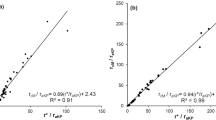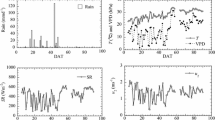Abstract
Greenhousing is a technique to bridge season gap in vegetable production and has been widely used worldwide. Calculation of water requirement of crops grown in greenhouse and determination of their irrigation schedules in arid and semi-arid regions are essential for greenhouse maintenance and have thus attracted increased attention over the past decades. The most common method used in the literature to estimate crop evapotranspiration (ET) is the Penman-Monteith (PM) formula. When applied to greenhouse, however, it often uses canopy resistance instead of surface resistance. It is understood that the surface resistance in greenhouse is the result of a combined effect of canopy restriction and soil-surface restriction to water vapor flow, and the relative dominance of one restriction over another depends on crop canopy. In this paper, we developed a surface resistance model in a way similar to two parallel resistances in an electrical circuit to account for both restrictions. Also, considering that wind speed in greenhouse is normally rather small, we compared three methods available in the literature to calculate the aerodynamic resistance, which are the r a 1 method proposed by Perrier (1975a, b), the r a 2 method proposed by Thom and Oliver (1977), and the r a 3 method proposed by Zhang and Lemeu (1992). We validated the model against ET of tomatoes in a greenhouse measured from sap flow system combined with micro-lysimeter in 2015 and with weighing lysimeter in 2016. The results showed that the proposed surface resistance model improved the accuracy of the PM model, especially when the leaf area index was low and the greenhouse was being irrigated. We also found that the aerodynamic resistance calculated from the r a 1 and r a 3 methods is applicable to the greenhouse although the latter is slightly more accurate than the former. The proposed surface resistance model, together with the r a 3 method for aerodynamic resistance, offers an improved approach to estimate ET in greenhouse using the PM formula.
Similar content being viewed by others
References
Allen R G, Pereira L S, Raes D, et al. 1998. Crop Evapotranspiration: Guidelines for Computing Crop Water Requirements FAO Irrigation and Drainage Paper 56, Rome, Italy: FAO.
Anadranistakis M, Liakatas A, Kerkides P, et al. 2000. Crop water requirements model tested for crops grown in Greece. Agricultural Water Management, 45(3): 297–316.
Bailey B J, Montero J I, Biel C, et al. 1993. Transpiration of Ficus benjamina: comparison of measurements with predictions of the Penman-Monteith model and a simplified version. Agricultural and Forest Meteorology, 65(3–4): 229–243.
Baille M, Baille A, Delmon D. 1994. Microclimate and transpiration of greenhouse rose crops. Agricultural and Forest Meteorology, 71(1–2): 83–97.
Brenner A J, Incoll L D. 1997. The effect of clumping and stomatal response on evaporation from sparsely vegetated shrublands. Agricultural and Forest Meteorology, 84(3): 187–205.
Camillo P J, Gurney R. 1986. A resistance parameter for bare-soil evaporation models. Soil Science, 141(2): 95–105.
Chen X M, Cai H J, Li H X, et al. 2007. Calculation and verification of crop evapotranspiration in greenhouse. Advances in Water Science, 18(6): 812–815. (in Chinese)
Fernández M D, Bonachela S, Orgaz F, et al. 2010. Measurement and estimation of plastic greenhouse reference evapotranspiration in a Mediterranean climate. Irrigation Science, 28(6): 497–509.
Fernández M D, Bonachela S, Orgaz F, et al. 2011. Erratum to: Measurement and estimation of plastic greenhouse reference evapotranspiration in a Mediterranean climate. Irrigation Science, 29(1): 91–92.
Gao Y, Duan A W, Qiu X Q, et al. 2013. Modeling evapotranspiration in maize/soybean strip intercropping system with the evaporation and radiation interception by neighboring species model. Agricultural Water Management, 128: 110–119.
Guo W Z, Chen Q Y, Gao L H, et al. 2005. Present situation and developmental tendency on system of water saving irrigation of vegetable production in protective cultivation. Transactions of the CSAE, 21 (Suppl.): 24–27. (in Chinese)
Gardiol J M, Serio L A, Della Maggiora A I. 2003. Modelling evapotranspiration of corn (Zea mays) under different plant densities. Journal of Hydrology, 271(1–4): 188–196.
Gröber H, Erk S. 1961. Fundamentals of heat transfer (3rd ed.). New York: McGraw-Hill, 288.
Ham J M, Heilman J L, Lascano R J. 1990. Determination of soil water evaporation and transpiration from energy balance and stem flow measurements. Agricultural and Forest Meteorology, 52(3–4): 287–301.
Iritz Z, Lindroth A, Heikinheimo M, et al. 1999. Test of a modified Shuttleworth-Wallace estimate of boreal forest evaporation. Agricultural and Forest Meteorology, 98–99: 605–619.
Jolliet O, Bailey B J. 1992. The effect of climate on tomato transpiration in greenhouses: measurements and models comparison. Agricultural and Forest Meteorology, 58(12): 43–62.
Juhász Á, Hrotkó K. 2014. Comparison of the transpiration part of two sources evapotranspiration model and the measurements of sap flow in the estimation of the transpiration of sweet cherry orchards. Agricultural Water Management, 143: 142–150.
Kato T, Kimura R, Kamichika M. 2004. Estimation of evapotranspiration, transpiration ratio and water-use efficiency from a sparse canopy using a compartment model. Agricultural Water Management, 65(3): 173–191.
Katsoulas N, Baille A, Kittas C. 2001. Effect of misting on transpiration and conductances of a greenhouse rose canopy. Agricultural and Forest Meteorology, 106(3): 233–247.
Kittas C, Katsoulas N, Baille A. 1999. Transpiration and canopy resistance of greenhouse soilless roses: measurements and modeling. Acta horticulturae. 507: 61–68.
Li S E, Hao X M, Du T S, et al. 2014. A coupled surface resistance model to estimate crop evapotranspiration in arid region of northwest China. Hydrological Processes, 28(4): 2312–2323.
Li S E, Zhang L, Kang S Z, et al. 2015. Comparison of several surface resistance models for estimating crop evapotranspiration over the entire growing season in arid regions. Agricultural and Forest Meteorology, 208: 1–15.
Liu H, Sun J S, Duan A W, et al. 2009. Experiment on soil evaporation of radish in sunlight greenhouse. Transactions of the CSAE, 25(1): 176–180. (in Chinese)
Liu C, Fan X K. 2012. Diagnosis of soil moisture in greenhouse based on canopy leaf-air temperature difference. Agricultural Research in the Arid Areas, 30(1): 90–93. (in Chinese)
Liu H, Duan A W, Li F S, et al. 2013. Drip irrigation scheduling for tomato grown in solar greenhouse based on pan evaporation in North China Plain. Journal of Integrative Agriculture, 12(3): 520–531.
Liu H, Duan A W, Sun J S, et al. 2011. Estimating model of transpiration for greenhouse tomato based on Penman-Monteith equation. Transactions of the CSAE, 27(9): 208–213. (in Chinese)
Mayer D G, Butler D G. 1993. Statistical validation. Ecological Modelling, 68(1–2): 21–32.
McAdams W H. 1954. Heat transmission (3rd ed.). New York: McGraw-Hill, 442.
Monteith J L. 1965. Evaporation and environment. Symposia of the Society for Experimental Biology, 19: 205–234.
Montero J I, Antón A, Muûoz P, et al. 2001. Transpiration from geranium grown under high temperatures and low humidities in greenhouses. Agricultural and Forest Meteorology, 107(4): 323–332.
Möller M, Tanny J, Li Y, et al. 2004. Measuring and predicting evapotranspiration in an insect-proof screenhouse. Agricultural and Forest Meteorology, 127(1): 35–51.
Perrier A. 1975a. Physical study of evapotranspiration in natural conditions. I. Evaporation and balance of energy of natural surfaces. Annales Agronomiques, 26: 1–18.
Perrier A. 1975b. Physical study of evapotranspiration in natural conditions. III. Actual and potential evapotranspiration of canopies. Annales Agronomiques, 26: 229–243.
Prenger J J, Fynn R P, Hansen R C. 2002. A comparison of four evapotranspiration models in a greenhouse environment. Transactions of the ASAE, 45(6): 1779–1788.
Qiu R J, Kang S Z, Du T S, et al. 2013. Effect of convection on the Penman-Monteith model estimates of transpiration of hot pepper grown in solar greenhouse. Scientia Horticulturae, 160: 163–171.
Qiu R J, Du T S, Kang S Z. et al. 2015. Influence of water and nitrogen stress on stem sap flow of tomato grown in a solar greenhouse. Journal of the American Society for Horticultural Science, 140(2): 111–119.
Rajan N, Maas S J, Kathilankal J C. 2010. Estimating Crop Water Use of Cotton in the Texas High Plains. Agronomy Journal, 102(6): 1641–1651.
Rouphael Y, Colla G. 2004. Modelling the transpiration of a greenhouse zucchini crop grown under a Mediterranean climate using the Penman-Monteith equation and its simplified version. Australian Journal of Agricultural Research, 55(9): 931–937.
Shuttleworth W J, Wallace J S. 1985. Evaporation from sparse crops-an energy combination theory. Quarterly Journal of the Royal Meteorological Society, 111(469): 839–855.
Stannard D I. 1993. Comparison of Penman-Monteith, Shuttle worth-Wallace, and modified Priestley-Taylor evapotranspiration models for wildland vegetation in semiarid rangeland. Water Resources Research, 29(5): 1379–1392.
Stanghellini C. 1987. Transpiration of greenhouse crops: an aid to climate management. PhD Dissertation. Wageningen: Wageningen Agricultural University, 31–88.
Stanghellini C. 1993. Mixed convection above greenhouse crop canopies. Agricultural and Forest Meteorology, 66(12): 111–117.
Thom A S, Oliver H R. 1977. On Penman’s equation for estimating regional evaporation. Quarterly Journal of the Royal Meteorological Society, 103(436): 345–357.
Villarreal-Guerrero F, Kacira M, Fitz-Rodríguez E, et al. 2012. Comparison of three evapotranspiration models for a greenhouse cooling strategy with natural ventilation and variable high pressure fogging. Scientia Horticulturae, 134: 210–221.
Wang S, Boulard T, Haxaire R. 1999. Air speed profiles in a naturally ventilated greenhouse with a tomato crop. Agricultural and Forest Meteorology, 96(4): 181–188
Wei R J, Sun Z F. 2014. Development and perspective of research on microclimate of sunlight greenhouse in china. Journal of northwest A&F university (Natural Science Edition), 42(12): 139–150. (in Chinese)
Yang X S, Short T H, Fox R D, et al. 1990. Transpiration, leaf temperature and stomatal resistance of a greenhouse cucumber crop. Agricultural and Forest Meteorology, 51(3–4): 197–209.
Yuan B Z, Kang Y H, Nishiyama S. 2001. Drip irrigation scheduling for tomatoes in unheated greenhouses. Irrigation Science, 20(3): 149–154.
Zhang L, Lemeur R. 1992. Effect of aerodynamic resistance on energy balance and Penman-Monteith estimates of evapotranspiration in greenhouse conditions. Agricultural and Forest Meteorology, 58(3–4): 209–228.
Zhang B Z, Kang S Z, Li F S, et al. 2008. Comparison of three evapotranspiration models to Bowen ratio-energy balance method for a vineyard in an arid desert region of northwest China. Agricultural and Forest Meteorology, 148(10): 1629–1640.
Zheng H, Yu G R, Wang Q F, et al. 2016. Spatial variation in annual actual evapotranspiration of terrestrial ecosystems in China: Results from eddy covariance measurements. Journal of Geographical Sciences 26(10): 1391–1411.
Acknowledgments
The study was funded by the Science and Technology Innovation Project of Chinese Academy of Agricultural Sciences (FIRI2016-07).
Author information
Authors and Affiliations
Corresponding author
Additional information
The first and second authors contribute equally to this work.
Rights and permissions
About this article
Cite this article
Gong, X., Liu, H., Sun, J. et al. A proposed surface resistance model for the Penman-Monteith formula to estimate evapotranspiration in a solar greenhouse. J. Arid Land 9, 530–546 (2017). https://doi.org/10.1007/s40333-017-0020-8
Received:
Revised:
Accepted:
Published:
Issue Date:
DOI: https://doi.org/10.1007/s40333-017-0020-8




